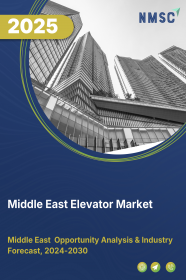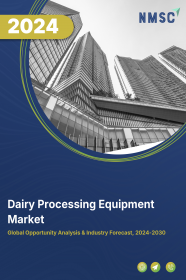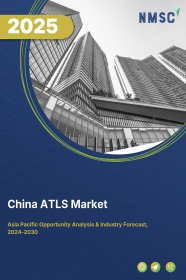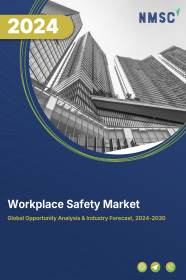
Middle East Elevator Market by Type (Passenger elevator, Freight elevator and Others), by Technology (Traction and Hydraulic), by Service (New Installation, Maintenance and Modernization), by Capacity (Less than 1500 kg, 1500 to 2500 kg, 2501 to 4000 kg and More than 4000 kg) by Speed (Less than 1 M/S, Between 1 to 4 M/S and More than 5 M/S) and Others- Opportunity Analysis and Industry Forecast, 2024 –2030
Industry: Construction & Manufacturing | Publish Date: 15-Feb-2025 | No of Pages: 241 | No. of Tables: 190 | No. of Figures: 135 | Format: PDF | Report Code : CM1663
Market Definition
Middle East Elevator Market size was valued at USD 1.25 billion in 2023, and is predicted to reach USD 2.38 billion by 2030, at a CAGR of 8.5 % from 2024 to 2030.
The elevator industry represents a dynamic sector encompassing the conception, production, installation, and maintenance of elevator systems. From conventional traction elevators to cutting-edge smart solutions, this market offers a diverse array of vertical transportation options tailored to suit the specific requirements of various buildings and infrastructure projects. Key stakeholders within the elevator market include manufacturers, suppliers, contractors, architects, building owners, and facility managers. Manufacturers continually innovate to enhance elevator performance, safety standards, and sustainability practices, while suppliers provide essential components and materials necessary for system assembly.
Furthermore, sustainability considerations such as energy efficiency and material recyclability are increasingly integrated into elevator design and operation, aligning with broader environmental objectives and sustainable building principles. As a result, the elevator market serves as a fundamental cornerstone of vertical mobility, enriching functionality, accessibility, and sustainability in buildings and urban landscapes worldwide.
Technical Advancements Within the Region is Surging the Growth of the Market
The elevator market is witnessing a significant growth due to the major technical advancements within the region, such as the integration of AI-driven predictive maintenance offers a substantial opportunity for the elevator market in the Middle East. Despite a market size of USD 1.2 billion, which is comparatively lower, harnessing AI technology has the potential to transform maintenance methodologies, reducing downtime and enhancing operational efficiency.
Although urbanization rates in the Middle East are slightly lower compared to certain Middle Eastn countries, implementing such innovative solutions can aid Middle Eastern nations in optimizing elevator performance. This ensures safer and more reliable transportation in urban areas, particularly in countries like Iran and Iraq, where a significant portion of the population resides.
Rising Infrastructure Development Drives the Growth of the Market
Infrastructure development initiatives represent another key driver for the Middle East elevator market. Despite the lower market size influenced by the region's urbanization rates, ongoing infrastructure projects across various sectors offer opportunities for elevator installations.
As countries like Iran and Iraq continue to urbanize, with 77.3% and 71.6% of their populations residing in urban areas respectively, there is a growing demand for modernized infrastructure including elevators in residential, commercial, and public buildings. Investment in infrastructure projects can drive the growth of the elevator market in the Middle East, catering to the evolving needs of urban populations and enhancing the overall quality of life in these regions.
High Initial Costs Obstruct Market Growth Within the Region
The substantial expenses associated with the installation, upkeep, and enhancement of elevators pose challenges to market expansion. From the initial installation costs to the ongoing maintenance charges and the need for upgrades to meet safety regulations and enhance energy efficiency, building owners encounter significant financial burdens.
These obstacles are particularly formidable for owners in economically disadvantaged regions or older structures. As a result, the elevated costs linked to elevators impede market growth across various geographical areas.
The Combination of Artificial Intelligence (AI) in Elevators Paves the Way for Future Opportunities for Growth
The incorporation of AI-powered predictive maintenance into the elevator sector presents a highly auspicious opportunity, transforming maintenance and operational methodologies through AI advancements. Utilizing data collected from elevator sensors, AI algorithms can forecast maintenance needs ahead of time, reducing downtime and optimizing elevator availability.
This proactive approach not only extends the longevity of elevator components but also enhances safety by predicting potential malfunctions, streamlining resource allocation, and yielding substantial cost savings for elevator companies.
Furthermore, well-maintained elevators enhance user satisfaction, thereby enhancing the overall experience for building occupants and visitors. Embracing AI-driven predictive maintenance empowers elevator firms to remain competitive and uphold service excellence in an ever-evolving market environment.
Competitive Landscape
The Middle East elevator market comprises various market players, such as Schindler Group, Otis Worldwide Corporation, TK Elevator (TKE), KONE Corporation, Fujitec Co. Ltd, Hyundai elevator Co. Ltd, Mitsubishi Electric Corporation, Toshiba Corporation, Hitachi Ltd., Epic Elevators Pvt. Ltd., Nibav Lifts Private Limited, Johnson Lifts, Massaed, Sigma Elevator Company, MENA Lifts and others.
Middle East Elevator Market Key Segments
By Type
-
Passenger elevator
-
Freight elevator
-
Others
By Technology
-
Traction
-
Machine Room [MR] Traction
-
Machine Roomless [MRL] Traction
-
-
Hydraulic
By Service
-
New Installation
-
Maintenance
-
Modernization
By Capacity
-
Less than 1500 kg
-
1500 to 2500 kg
-
2501 to 4000 kg
-
More than 4000 kg
By Speed
-
Less than 1 M/S
-
Between 1 to 4 M/S
-
More than 5 M/S
By Deck Type
-
Single Deck
-
Double Deck
By Designation Control
-
Smart
-
Conventional
By Door Type
-
Automatic
-
Manual
By Operation
-
Low-Rise
-
Mid-Rise
-
High-Rise
By Application
-
Residential
-
Commercial
-
Industrial
REPORT SCOPE AND SEGMENTATION:
|
Parameters |
Details |
|
Market Size in 2023 |
USD 1.25 Billion |
|
Revenue Forecast in 2030 |
USD 2.38 Billion |
|
Growth Rate |
CAGR of 8.5 % from 2024 to 2030 |
|
Analysis Period |
2023–2030 |
|
Base Year Considered |
2023 |
|
Forecast Period |
2024–2030 |
|
Market Size Estimation |
Billion (USD) |
|
Growth Factors |
|
|
Companies Profiled |
15 |
|
Market Share |
Available for 10 companies |
|
Customization Scope |
Free customization (equivalent up to 80 working hours of analysts) after purchase. Addition or alteration to country, regional, and segment scope. |
|
Pricing and Purchase Options |
Avail customized purchase options to meet your exact research needs. |
KEY PLAYERS
-
Schindler Group
-
Otis Worldwide Corporation
-
TK Elevator (TKE)
-
KONE Corporation
-
Fujitec Co. Ltd
-
Hyundai elevator Co. Ltd
-
Mitsubishi Electric Corporation
-
Toshiba Corporation
-
Hitachi Ltd.
-
Epic Elevators Pvt. Ltd.
-
Nibav Lifts Private Limited
-
Johnson Lifts
-
Massaed
-
Sigma Elevator Company
-
MENA Lifts

















 Speak to Our Analyst
Speak to Our Analyst




















